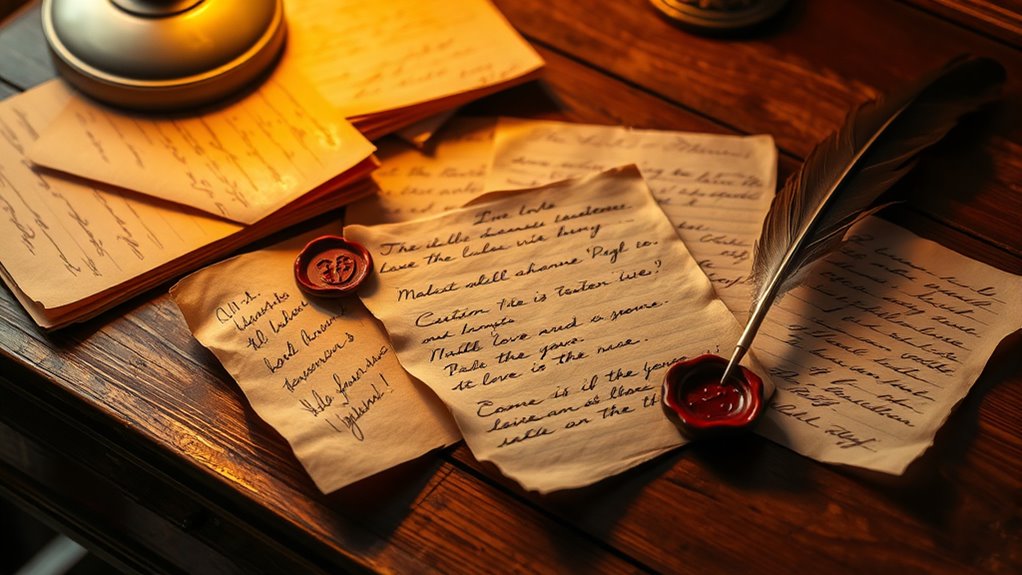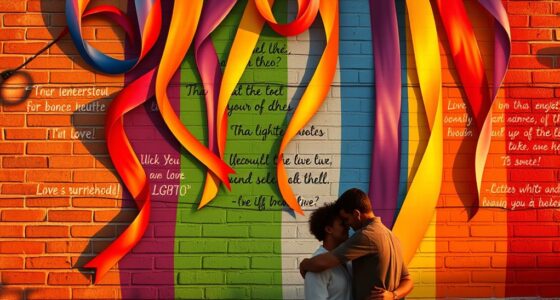Famous love letters reveal timeless lessons about vulnerability, sincere emotion, and the power of words to forge deep connections across distances. They show how heartfelt messages can express hope, passion, and honesty, teaching us that genuine love involves openness and sincerity. By exploring these timeless expressions, you’ll discover how words can leave lasting impressions and bridge emotional gaps. Keep exploring, and you’ll uncover even more inspiring insights about love’s enduring power.
Key Takeaways
- They reveal authentic emotions, vulnerability, and personal insights that deepen our understanding of love’s complexity.
- These letters reflect societal norms and cultural values, showing how love is expressed across different eras.
- They demonstrate the power of heartfelt words to bridge physical and emotional distances over time.
- Famous examples highlight love’s enduring, universal nature, inspiring genuine expression and connection today.
- Analyzing these letters teaches us how sincere, thoughtful communication can leave lasting emotional impacts.

Love letters have long served as intimate expressions of emotion, capturing the depth of affection and longing between partners. These handwritten notes have historically been more than just words; they’re windows into the personal lives, passions, and vulnerabilities of those who penned them. When you look at famous love letters, you’re not only reading heartfelt romantic expressions but also exploring the historical context that shaped their tone and significance. For example, during times of war or political turmoil, love letters often became cherished tokens of hope and connection, reminding couples of the enduring power of love amid chaos.
Understanding the historical context behind these letters helps you appreciate their true meaning. In centuries past, written correspondence was one of the few ways lovers could communicate across distances, making each letter a treasured possession. The language used in these messages reveals societal norms, gender roles, and cultural values of their respective eras. For instance, Victorian love letters often contained elaborate language and formalities that reflected the decorum of the time, while romantic expressions during the Romantic era focused on emotion and individual passion. By studying these letters, you gain insight into how love was expressed and understood in different historical periods.
When you read a famous love letter, you see how personal feelings are conveyed through carefully chosen words and phrases. The tone can range from tender and poetic to passionate and urgent, depending on the context. These letters also teach you that love isn’t static; it’s dynamic, layered, and deeply personal. The writers often reveal their innermost thoughts, fears, and hopes, giving you a glimpse of their authentic selves. They demonstrate vulnerability and sincerity that transcend time, reminding you that genuine love involves honesty and openness. Additionally, examining these letters allows you to recognize the enduring influence of historical context on personal expressions of love.
Moreover, these letters set a standard for romantic expressions that still influence how we communicate love today. They serve as timeless examples of how words can bridge physical distance and emotional gaps. Whether it’s a note from a famous figure like Beethoven or a lesser-known letter from a soldier to his beloved, each one offers lessons on the importance of heartfelt communication. They encourage you to express your feelings honestly and thoughtfully, recognizing that words, when crafted with care, can leave a lasting impact. Ultimately, the enduring power of these love letters lies in their ability to capture the universal human experience of love—intimate, passionate, and full of hope.
Frequently Asked Questions
How Did Historical Events Influence the Content of Famous Love Letters?
You see, historical events like wars and societal norms greatly shape love letters. War impact often makes lovers express more longing and sacrifice, highlighting the emotional toll of conflict. Meanwhile, societal norms influence how openly they can share feelings or address social expectations. These external pressures mold the tone and content of their messages, revealing how personal love intertwines with larger historical forces, creating powerful, heartfelt expressions amid turbulent times.
What Psychological Insights Can Be Gained From Reading Love Letters?
When you read love letters, you uncover valuable psychological insights about emotional vulnerability and attachment styles. You see how people express their deepest feelings, revealing their fears and hopes. Recognizing these patterns helps you understand how attachment influences relationships, fostering empathy and self-awareness. By observing emotional openness, you can learn how vulnerability strengthens bonds and how different attachment styles shape the way people connect emotionally.
Are There Modern Equivalents to These Famous Love Letters?
You can find modern equivalents in digital communication and social media, where people share heartfelt messages, private thoughts, and declarations of love. These platforms often serve as digital love letters, revealing your emotions and personality. By observing how you express affection online, you gain insights into your psychological state and relationship dynamics. Just like classic love letters, social media shares help you understand yourself and your connections better.
How Did Literacy Levels Affect the Style of Love Letters Across Eras?
You see, literacy evolution greatly influences how love letters are written across eras. When literacy levels are high, you’ll notice more stylistic differences, with intricate language and personalized touches. Conversely, in times of lower literacy, love letters tend to be simpler, more direct, and often rely on oral traditions. This shift shapes not just the content but also the emotional depth conveyed, reflecting societal changes and access to education over time.
What Privacy Considerations Surround the Preservation of Historic Love Correspondence?
You should consider privacy concerns and archival ethics when preserving historic love correspondence. While these letters reveal personal stories, they often contain private details that can impact individuals’ lives today. Balancing the public’s interest with respect for the writers’ privacy is essential. As a researcher or archivist, you must carefully handle these documents, ensuring ethical standards are met and sensitive information is protected from misuse or unauthorized access.
Conclusion
Just like those timeless love letters, your words have the power to bridge gaps and ignite passions. Imagine a simple note that, decades later, still makes someone smile or cry—proving that heartfelt expression endures beyond time. Love letters remind you that sincerity and vulnerability create lasting connections. So, don’t hold back your feelings; your words could become a cherished story, just like the ones that have inspired generations before you.









